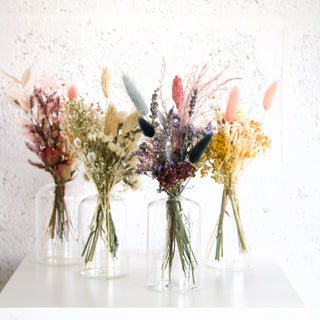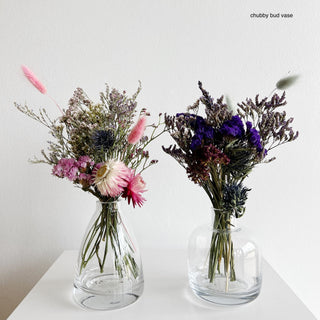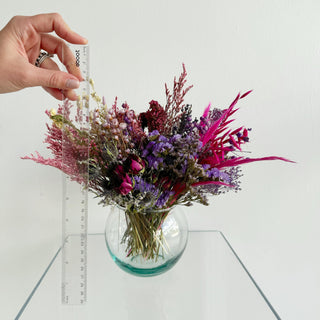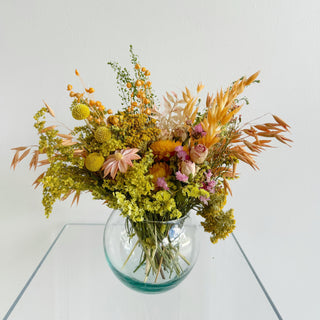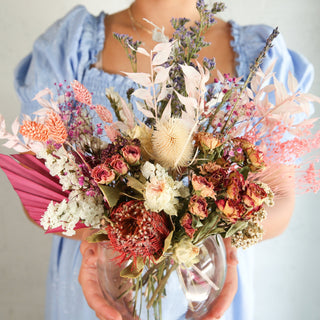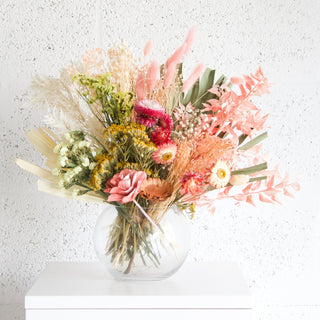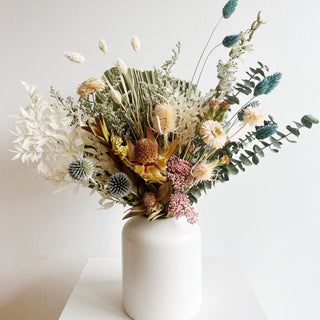frequently asked questions
Dried flowers are a decorative item that has been around for hundreds of years. They can be used to create beautiful displays, add texture and color to interiors, and even provide aromatherapy benefits. Generally, dried flowers are flowers that have been air-dried or dehydrated in an oven to retain their shape, hue and scent. Many florists offer a variety of dried flowers including roses, lilies, daisies and more, so you can choose the best option for your project.
While flower preservation can keep your blooms looking beautiful for years to come, dried flowers are a budget-friendly way to add some color and texture to your space. Sure, they won't have the same vibrant colors or scent of fresh flowers, but they require minimal maintenance and they last much longer than their fresh counterparts - making them a great choice for those home décor projects.
Drying flowers is a relatively simple process. The most common method is air-drying, which requires the flower to be hung upside down in a cool and dark area for several weeks until all moisture has evaporated. Alternatively, you can also use an oven for faster results, however heat drying tends to result in discoloration of the petals due to oxidation. Whichever method you choose, make sure that the flowers are completely dry before storing them away as even a small amount of moisture can lead to mold or deterioration.
After drying, the best places to store your flowers are cool, dry and dark. An airtight box or container will keep the petals from getting brittle or crushed. Alternatively, you can also frame them in a shadow box for decoration. Make sure to check on them regularly though, as prolonged storage in such environments can cause further fading or discoloration of the petals.
The lifespan of dried flowers will depend upon the environment in which they are stored. Generally, preserving them properly can extend their life up to one year or more. Proper care and protection is key - make sure you avoid keeping them in close range of direct sunlight, heat sources, and moisture.
Time can have a number of effects on dried flowers. Constant exposure to light, heat, and moisture will cause the petals to fade and discolor, while storage in cool, dry environments will preserve them for longer periods. Additionally, over time the flowers may become brittle and fragile, making them more prone to breakage or damage from handling.
To extend the life of your dried flowers, follow these steps:
- Keep them in a cool, dry, and dark location away from direct sunlight and other sources of heat.
- Fill their container or vase with silica or crushed tissue paper for support to prevent wilting.
- Check periodically for any signs of mold and mildew and discard affected flowers immediately.
Following these steps can help prolong the life of your dried flowers for up to one year or more.
Dried flowers can be a great way to bring a lasting beauty and charm to any space. They are an economical choice, as they last longer than fresh-cut flowers and require less maintenance. Additionally, dried flower arrangements will stay in bloom all year round, offering consistent color to your home or office throughout the seasons. Whether they are used as accents in existing planters or displayed solo in vases, dried flowers offer unique texture, shape and form that adds interest and beauty to any room.
The best-dried flowers for use in arrangements and projects are roses, hydrangeas, gypsophila, larkspur, ammobium, celosia and lavender. All of these varieties retain their shape and color well when dried, allowing them to be used in a variety of creative and decorative ways. Roses are particularly striking when dried, with the ruffled edges of each petal adding dimension to any arrangement. Hydrangeas also retain their large blooms long after drying, providing a burst of color and texture. Dried larkspur offers delicate clusters of tiny blossoms that are perfect for filling in gaps in larger arrangements, while ammobium's unique blooming heads remain open even after being dried. Celosia is another dramatic option that comes in bright shades such as reds, oranges and pinks. Finally, the subtle beauty of dried lavender brings an undeniably peaceful aura to any space.
While it's possible for dried flowers to get mold, it's not all that common. The best way to prevent it is by ensuring the flowers are completely dry before arranging them. If you're using fresh-cut stems, allow the flowers to dry in a cool, dark place (such as an attic or basement) for 1-2 weeks before arranging. Additionally, make sure that there is adequate air circulation around the arrangement and consider adding silica gel packets to help absorb any moisture. Finally, when storing arrangements for longer periods of time, keep them in an airtight container away from moisture sources like windows or bathrooms.
Dried flowers can attract bugs such as silverfish and beetles, which may be attracted to the petals for food or shelter. To help prevent any infestation, it is important to store your dried flower arrangements in an area that is not exposed to direct sunlight and away from sources of moisture. Additionally, you should inspect the arrangements regularly to look for signs of insect activity, such as webbing or chewed petals. If such signs are present, it is best to dispose of the arrangement immediately.
Generally, dried flowers do not need to be watered as they are already dry. However, if the petals become wilted or brittle over time from exposure to environmental elements, it is possible to rehydrate them using a light mist of water. This can help revive the colors and texture of the petals and keep them looking vibrant and beautiful for longer.
Dried flowers have a variety of symbolic meanings depending on the type and color of flower. Generally, they are seen to represent endurance, strength, and resilience in the face of adversity. They can also symbolize longevity or eternal love, as dried flowers when properly care for can maintain their vibrancy for years.
Dried flowers are typically more expensive than fresh flowers because they require more work to cultivate and preserve. The process of drying flowers is delicate and time-consuming, as the petals must be properly dried with low heat in order to maintain their color and texture. Additionally, packaging for dried flowers must also be taken into account when considering price since unique containers or other materials may be used for display purposes.
Dried flowers may start to smell foul when they are not cared for properly. This can happen as a result of over-watering or storing the flowers in humid environments, which effectively causes mildew growth. Dried flowers must be stored and handled with care in order to prevent the flowers from developing a bad odor.
